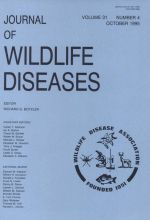Notoedric mange was diagnosed in a free-ranging adult male ocelot (Felis pardalis) found dead in April 1994 in southern Texas (USA). The emaciated carcass had no body fat. The heart was enlarged and flaccid. There was a nonpurulent serosanguineous pericardial and peritoneal exudate. Severe encrusted skin lesions and alopecia extended from the head posteriorly to the shoulders. The forelegs and feet were less severely affected. We observed a massive infection of Notoedres cati in skin scrapings. Epidermal lesions included hyperkeratosis and parakeratosis with necrotic debris and foci of acute inflammatory cells surrounding mites and their eggs in the stratum corneum. There was mild acanthosis and spongiosis of the stratum germativum, but no chronic inflammation in the dermis. This is the first confirmed case in the ocelot, but notoedric mange has been reported from the bobcat (Felis rufus) in southern Texas. Thus, notoedric mange could pose an additional threat to the already endangered remnant population of the ocelot.
How to translate text using browser tools
1 October 1995
Notoedric Mange in an Ocelot (Felis pardalis) from Southern Texas
Danny B. Pence,
Michael E. Tewes,
David B. Shindle,
Dale M. Dunn

Journal of Wildlife Diseases
Vol. 31 • No. 4
October 1995
Vol. 31 • No. 4
October 1995
case report
Felis pardalis
mortality
Notoedres cati
notoedric mange
ocelot




